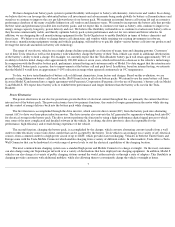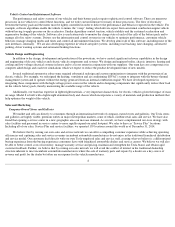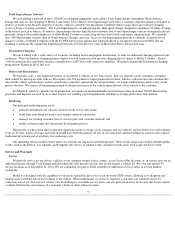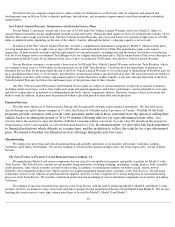Tesla 2015 Annual Report Download - page 17
Download and view the complete annual report
Please find page 17 of the 2015 Tesla annual report below. You can navigate through the pages in the report by either clicking on the pages listed below, or by using the keyword search tool below to find specific information within the annual report.
Risks Related to Our Business and Industry
We may experience significant delays or other complications in the design, manufacture, launch and production ramp of Model X, as
well as future vehicles such as Model 3, which could harm our brand, business, prospects, financial condition and operating results.
We may experience significant delays or other complications in bringing new vehicles to market. For example, while we expect Model X
deliveries to start in the third quarter of 2015, refinements resulting from ongoing development and extensive testing of this vehicle could result
in delays in its introduction. Complications could also arise from other factors, including the expansion of our production capacity required to
bring Model X to market, finalization of it supply chain, and completion of regulatory approvals. Ahead of the Model X launch, we plan to
expand capacity in several areas for our current and future vehicles, including installing a state of the art, highly automated casting and
machining operation for various aluminum components for our vehicles, increasing production on our new drive unit line, installing a new
robotic body assembly shop for Model X production and commissioning a new paint facility. Our suppliers may not be able to provide
components in a timely manner, at an acceptable price or in the necessary quantities. Finally, we will also need to do extensive testing to ensure
that Model X is in compliance with applicable NHTSA safety regulations and obtain EPA and CARB certification to emission regulations prior
to beginning volume production and delivery of the vehicles.
We, as well as other automobile manufacturers, have experienced delays or other complications in connection with new vehicle models.
In 2012, we experienced delays in the production ramp of Model S and in 2014, we delayed the start of production ramp of All-Wheel Drive
Dual Motor Model S. Any significant delay or other complication in the development, manufacture, launch and production ramp of Model X or
our future vehicles, including complications associated with expanding our production capacity, supply chain or regulatory approvals, could
materially damage our brand, business, prospects, financial condition and operating results.
Our long-term success will be dependent upon our ability to design, build and achieve market acceptance of new vehicle models,
specifically Model S and new vehicle models such as Model X and Model 3.
Our long-term success is dependent on market acceptance of the Model S sedan and future electric vehicles we introduce. In the United
States, there is no guarantee that Model S will continue to be successfully accepted by the general public, especially in the long-term. As we
expand in Europe and Asia, there is no guarantee that customers in these markets will embrace our vehicles and if they do not, demand for our
vehicles could be lower than our expectations.
Moreover, there can be no assurance that we will be able to design future electric vehicles that will meet the expectations of our customers
or that our future models, including the Model X crossover, will become commercially viable. To date, we have publicly revealed only an early
prototype of the Model X. Work continues on the finalization of Model X with Beta Model X vehicles undergoing extensive testing. To the
extent that we are not able to build Model X in accordance with the expectations created by the early prototype and our announced specifications
and schedule, customers may cancel their reservations, our future sales could be harmed and investors may lose confidence in us.
In addition, we have also announced our intent to develop Model 3 which we expect to produce at the Tesla Factory after the introduction
of Model X. We intend to offer this vehicle at a lower price point and expect to produce it at higher volumes than our Model S. Importantly, we
anticipate producing Model 3 for the mass market and thus we will need a high-volume supply of lithium-ion cells at reasonable prices.
While we intend each of our production vehicles and their variants to meet a distinct segment of the automotive market, our vehicles may
end up competing with each other which may delay sales and associated revenue to future periods. Also, if we fail to accurately anticipate
demand for each of our vehicles, this could result in inefficient expenditures and production delays. Furthermore, historically, automobile
customers have come to expect new and improved vehicle models to be introduced frequently. In order to meet these expectations, we may be
required to introduce on a regular basis new vehicle models as well as enhanced versions of existing vehicle models. As automotive technologies
change, including those specific to electric vehicles, we anticipate our customers will expect us to upgrade or adapt our vehicles and introduce
new models in order to continue to provide vehicles with the latest technology. To date, we have limited experience simultaneously designing,
testing, manufacturing, upgrading, adapting and selling our electric vehicles as well as limited experience allocating our available resources
among the design and production of multiple vehicles.
16
























